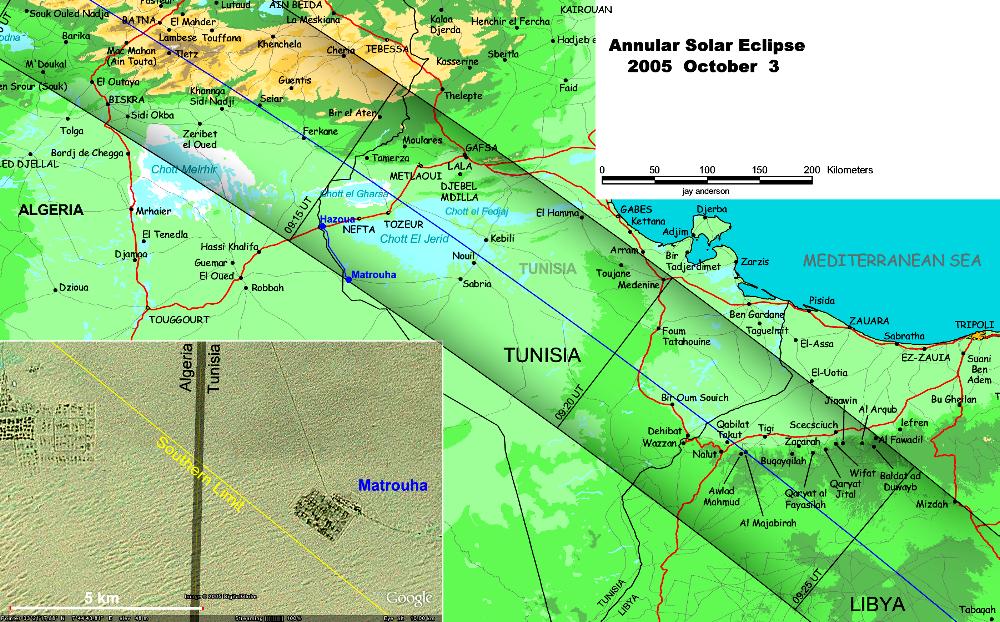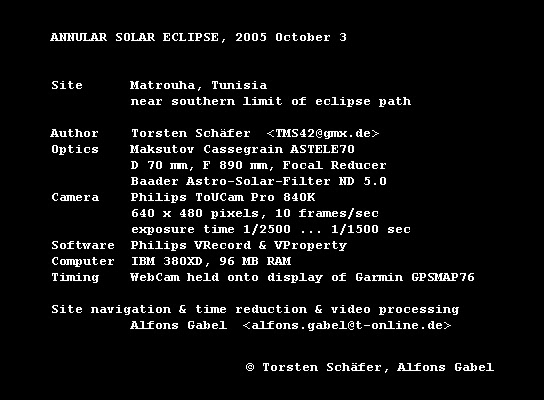Annular Solar Eclipse, 2005 Oct 3 - Scaling the variable Sun
The determination of long-term variations of the solar diameter is one of IOTA's
objectives. Therefore IOTA/ES has reinstalled a working group on the
reduction of solar eclipse data. To gain valuable data, Baily's beads
have to be recorded and thoroughly timed along the edges of the
eclipse path.

According to informations from several observers and teams, the northern edge of the annular
eclipse on October 3rd apparently was covered much better than the
southern one. Also the weather prospects for southern Tunisia were
more favourable than for Iberia. So I decided to go to the only place
at the southern edge in Tunisia, which was accessible via a paved
track: Matrouha, a tiny oasis in the Sahara desert close to the
Algerian border and south-west of the vast salt lake Chott el Jerid.
When we arrived it was raining in this normally dust-dry area. The
Chott itself, normally a concrete-hard salt plain, had become a salt
swamp or even a lake. Unbelievable! But the eclipse day was clear and
sunny.

"
Torsten Schaefer and
myself built up two webcam stations for Baily's Bead recording near
Matrouha. Michael Schmidt completed our team from Mainz/Germany - you
may have a look on some of his photographs on
http://www.mathe-schmidt.net/INTBILD.HTML.
In Tunisia we met Konrad
Guhl from Berlin and his family, who successfully operated another
two stations in the palm grove of Matrouha.
Despite all successful tests in advance, my own
webcam station failed due to a software crash just before the maximum
of the grazing eclipse. 200 m inwards the eclipse path Torsten
Schaefer successfully recorded a webcam video of Baily's beads.

"
I had scheduled the positions of our stations using the Baily's bead module of Dave
Herald's program winOccult 3.1.0. Although the stations were spaced
by only 400 m perpendicular to the limit line, Torsten was
definitively within the zone of annularity, while Konrad was just
outside, as intended. Well done, Dave!


 "
Torsten Schaefer and
myself built up two webcam stations for Baily's Bead recording near
Matrouha. Michael Schmidt completed our team from Mainz/Germany - you
may have a look on some of his photographs on
http://www.mathe-schmidt.net/INTBILD.HTML.
"
Torsten Schaefer and
myself built up two webcam stations for Baily's Bead recording near
Matrouha. Michael Schmidt completed our team from Mainz/Germany - you
may have a look on some of his photographs on
http://www.mathe-schmidt.net/INTBILD.HTML. "
"